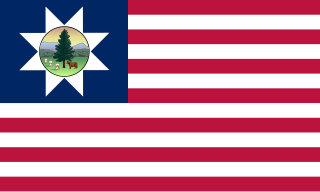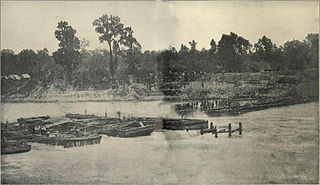
United States Colored Troops (USCT) were Union Army regiments during the American Civil War that primarily comprised African Americans, with soldiers from other ethnic groups also serving in USCT units. Established in response to a demand for more units from Union Army commanders, USCT regiments, which numbered 175 in total by the end of the war in 1865, constituted about one-tenth of the manpower of the army, according to historian Kelly Mezurek, author of For Their Own Cause: The 27th United States Colored Troops. "They served in infantry, artillery, and cavalry." Approximately 20 percent of USCT soldiers were killed in action or died of disease and other causes, a rate about 35 percent higher than that of white Union troops. Numerous USCT soldiers fought with distinction, with 16 receiving the Medal of Honor. The USCT regiments were precursors to the Buffalo Soldier units which fought in the American Indian Wars.
The Battle of Fort Bisland was fought in the American Civil War between Union Major General Nathaniel P. Banks against Confederate Major General Richard Taylor during Banks' operations against the Bayou Teche region in southern Louisiana.

The 8th Vermont Infantry Regiment was a three-year infantry regiment in the Union Army during the American Civil War. It served in both major theaters, first in Louisiana and then in Virginia, from February 1862 to June 1865. It was a member of the XIX Corps.
The 91st Regiment Illinois Volunteer Infantry was an infantry regiment that served in the Union Army during the American Civil War.
African Americans, including former enslaved individuals, served in the American Civil War. The 186,097 black men who joined the Union Army included 7,122 officers and 178,975 enlisted soldiers. Approximately 20,000 black sailors served in the Union Navy and formed a large percentage of many ships' crews. Later in the war, many regiments were recruited and organized as the United States Colored Troops, which reinforced the Northern forces substantially during the conflict's last two years. Both Northern Free Negro and Southern runaway slaves joined the fight. Throughout the course of the war, black soldiers served in forty major battles and hundreds of more minor skirmishes; sixteen African Americans received the Medal of Honor.

The 1st Louisiana Native Guard was a Confederate Louisianan militia that consisted of Creoles of color. Formed in 1861 in New Orleans, Louisiana, it was disbanded on April 25, 1862. Some of the unit's members joined the Union Army's 1st Louisiana Native Guard, which later became the 73rd Regiment Infantry of the United States Colored Troops.
The 3rd Louisiana Regiment Native Guard Infantry was a regiment in the Union Army during the American Civil War.
The 2nd Louisiana Regiment Native Guard Infantry was a regiment in the Union Army during the American Civil War. It was organized in New Orleans and was tasked with defending the city until being redeployed to Ship Island in Mississippi. Its higher-ranking officers were white and lower grade officers and enlisted men were mixed heritage and African American.

The 1st Louisiana Native Guard was the first all-black regiment in the Union Army. Based in New Orleans, Louisiana, it played a prominent role in the Siege of Port Hudson. Its members included a minority of free men of color from New Orleans; most were African-American former slaves who had escaped to join the Union cause and gain freedom. A Confederate regiment by the same name served in the Louisiana militia made up entirely of free men of color.
The 51st United States Colored Infantry Regiment was an infantry regiment composed of African-American troops recruited from Mississippi that served in the Union Army during the American Civil War. Initially formed in the spring of 1863 as the 1st Regiment Mississippi Volunteer Infantry (African Descent), the Regiment took part in fierce fighting at the Battle of Milliken's Bend, served on garrison duty in Louisiana, and then took part in the Battle of Fort Blakeley, the last major battle of the war.

The Corps d'Afrique was an African American corps that served in the Union Army during the American Civil War.
The 52nd United States Colored Infantry was an infantry regiment composed of African-American troops recruited from Mississippi that served in the Union Army during the American Civil War. On July 4, 1864, the 52nd Colored Infantry fought a battle at Coleman's Plantation in Jefferson County, Mississippi. This engagement is notable as it is most likely the first time that Black soldiers from Mississippi fought against white Confederates from the same state.
The 53rd United States Colored Infantry was an infantry regiment that served in the Union Army during the American Civil War. Originally formed as the 3rd Regiment Mississippi Volunteers (African Descent), the regiment was composed of African American enlisted men commanded by white officers. The 53rd served on garrison duty in Louisiana, Mississippi, and Arkansas before being mustered out of service in 1866.
The 58th United States Colored Infantry was an infantry regiment that served in the Union Army during the American Civil War. Originally organized as the 6th Mississippi Infantry (African Descent) on August 27, 1863, the regiment was redesignated as the 58th USCT Infantry on March 11, 1864. The regiment was composed of African American enlisted men from Mississippi commanded by white officers.
The 61st United States Colored Infantry was an infantry regiment that served in the Union Army during the American Civil War. The regiment was composed of African American enlisted men commanded by white officers and was authorized by the Bureau of Colored Troops which was created by the United States War Department on May 22, 1863. The non-commissioned officers (sergeants and corporals) and enlisted men were African Americans. The regiment was originally organized as the 2nd Tennessee Volunteer Infantry (African Descent) and was also referred to as the 2nd West Tennessee Infantry Regiment (African Descent).

The 97th United States Colored Infantry was an engineer regiment designated as infantry as part of the United States Colored Troops that served in the Union Army during the American Civil War and fought in the Western Theater of the American Civil War in the Department of the Gulf. The regiment mustered in at Camp Parapet April 28, 1863, as the 1st Louisiana Engineers, but two companies, D and F had been hastily mustered into service two days earlier, April 26, 1863, and sent to Berwick City to remove obstructions from the Bayou Teche. The enlisted men of the 1st Louisiana Engineers were formerly enslaved men in the “engineer camp” who had been previously providing labor for the U.S. Army between New Orleans and Baton Rouge. Several of the newly commissioned company grade officers had been enlisted men of the 42nd Massachusetts Volunteer Infantry who had been on engineer service superintending the contraband laborers from the camp. In the summer of 1862, General Phelps had previously requested to arm the men at Camp Parapet and put them in uniform to defend the city of New Orleans but his request was denied. Gen. Banks ordered Phelps to have the men cut down all the trees between Camp Parapet and Lake Pontchartrain. Phelps resigned over the issue stating, "...while I am willing to prepare African regiments for the defense of the government," he continued, that he " was not willing to become a mere slave driver."

3rd Regiment, United States Colored Heavy Artillery was a unit of the United States Army based in West Tennessee during the American Civil War. According to a 2003 article in the journal Army History, "More than 25,000 black artillerymen, recruited primarily from freed slaves in Confederate or border states, served in the Union Army during the Civil War...Federal military authorities armed and equipped the soldiers in these twelve-company heavy artillery regiments as infantrymen and ordinarily used them to man the larger caliber guns defending coastal and field fortifications located near cities and smaller population centers in Louisiana, Mississippi, Tennessee, Kentucky, and North Carolina."

81st Regiment Infantry U.S. Colored Troops was a regiment of United States Colored Troops during the American Civil War. Initially formed as the 9th Infantry, Corps d'Afrique on September 2, 1863, the regiment was re-designated as the 81st Regiment Infantry on April 4, 1864. It primarily served at Port Hudson, Louisiana, and was mustered out on November 30, 1866.

The 4th United States Colored Cavalry Regiment was an African American cavalry regiment that served in the Union Army during the American Civil War. The regiment mustered in as the 1st Cavalry (Corps d'Afrique) at New Orleans on September 12, 1863 and was stationed for the entirety of its existence at various bases throughout Louisiana, mustering out at New Orleans on March 20, 1866.
The 66th United States Colored Infantry Regiment was an infantry regiment composed of African-American troops recruited from Mississippi that served in the Union Army during the American Civil War. The 66th Regiment was posted on garrison duty in Mississippi, Louisiana, and Arkansas, and fought several skirmishes with Confederate troops around the Mississippi River before being mustered out of service in 1866.








